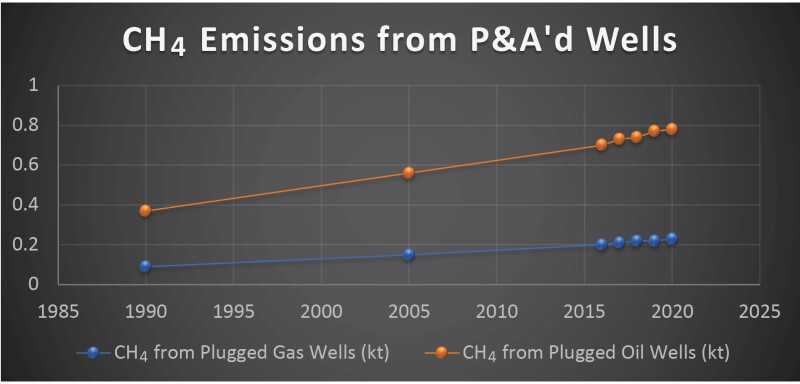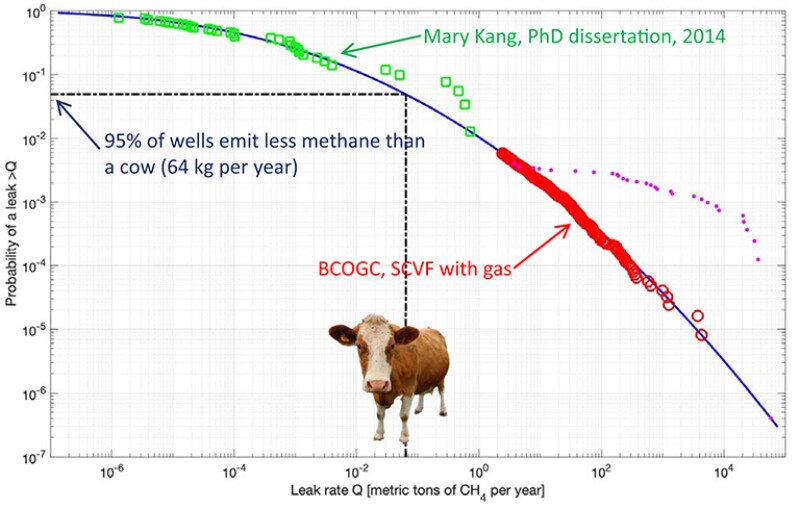It seems logical to follow up on last month’s article on rehabilitating or revitalizing underperforming and/or inactive wells with an appeal to
- “Get real” about well repurposing opportunities.
- “Get on” with abandonment and decommissioning those wells that are unlikely to be repurposed and/or pose an environmental risk with emissions into the atmosphere or aquifers.
The massive, but ill-defined inventory of suspended, orphaned, and/or poorly abandoned wells worldwide has caught the attention of our detractors and is undermining our social license to operate. Some of those wells are known to be emitting methane directly into the atmosphere or into agricultural-grade or potable water aquifers and/or are conduits for oil-contaminated, saltwater flows. Moreover, many industry watchers and investors are also openly speculating whether some industry players have adequate provisions on their balance sheets for the mounting decommissioning liabilities. There is no doubt that existing well penetrations represent a significant risk for those looking at carbon capture and storage and/or at repurposing the existing well stock for concentrated brine, acid gas, or liquid industrial waste disposal.
The Environmental Defense Fund (EDF) and the International Energy Agency (IEA) are keen to put together some estimates on the worldwide size of the orphan and suspended-well inventories, the potential emissions that may be occurring, and the longer-term risks that are posed by these wells. Similarly, I would suspect that the new business development teams for the international and regional well service providers are also keen to have a clearer picture of the business opportunities that an accelerated plug and abandonment (P&A) effort might represent. Clearly, the associated emissions represent a potential market opportunity for those involved in the provision of carbon offsets.
The EDF has proposed a joint industry project (JIP) be conducted by a reputable international consultancy in 4Q2022 to get a clearer picture of the inventories on a regional basis and are currently looking for modest amounts of funding for this effort. Obviously, the individual contributions will depend on the number of participating entities, but it seems likely to be well within the underspend on many company budgets for 2022 (less than $50,000 per entity).
The key contact for this initiative is Adam Peltz, director and senior attorney, energy transition at EDF (apeltz@edf.org). On behalf of SPE, I have had the pleasure of working with Adam over the past few years in his other role as the current chair of the Energy Resources Research & Technology Committee of the Interstate Oil & Gas Compact Commission (IOGCC, the council of the North Americas regulators).
In a recent SPE webinar sponsored by the IOGCC, EDF, and SPE Foundation, Tessa Sorensen, a professor of practice at the Colorado School of Mines, summarized the geometry, capacity, well integrity, design, and the cost challenges in repurposing suspended wells for a completely new service. Repurposing is particularly problematic with old wells for which the well records are incomplete or have been lost during the transfer between operators. She introduced some of us to the term “boomerang wells,” which may come back to the original operator, either because of merger and acquisition activities to reacquire the rights to other prospective resources or because of the insolvency of the current owners. With a significant timelapse, much of the well data is often lost.
She showed an interesting plot based on an US Environmental Protection Agency (EPA) a report on the 2022 Inventory of US Greenhouse Gas Emissions and Sinks suggesting that methane emissions from US suspended wells have been increasing over time, and especially from former oil wells. While this is likely primarily driven by the increasing size of the inventory, it seems possible that leakage rates at problematic wells may also increase with age, corrosion, flow erosion and/or as differential pressures increase.

Other speakers in the webinar, Rob Lowe and Jason Simmerman, both with the Ohio Department of Natural Resources, Division of Oil and Gas Resources Management, reminded us that many wells were drilled and/or abandoned long before the modern regulatory frameworks and standard operating practices came into effect in the second half of the past century. Finding these orphan wells in old fields is a massive challenge, even with the help of aerial surveys and drone-mounted and/or handheld magnetometers. They have some spectacular examples showing how challenging is it to re-abandon some of the ancient orphan wells under people’s driveways or in someone’s backyard in Ohio.

This webinar ties back to the June 2021 SPE-IOGCC-EDF webinar on “Cost-Effective Technologies for Onshore Well Abandonments and Verification.” In that webinar, Matteo Loizzo (an independent consultant based in Berlin, Germany), speaking on behalf the SPE Well Integrity Technical Section, made a strong pitch to focus our initial efforts on the ±2% of wells that are emitting more methane each year than, say, “a small heard of cows.” This discussion around acceptable near-term methane leakage rates from suspended or previously abandoned wells continues with an extended discussion train on Loizzo’s LinkedIn page.

Source: Matteo Loizzo. (BCOGC - BC Oil and Gas Commission; SCVF - surface casing vent flow). Dissertation by M. Kang (2014) http://arks.princeton.edu/ark:/88435/dsp019s1616326.
It is my belief that operators need to build momentum and credibility by focusing their immediate efforts and spending on projects that will demonstrate material changes to the evolving baseline of regional emissions measurements by third-party satellites and flyover surveys. We collectively need to use this data and our own drone surveys to identify those wells that are clearly problematic. Remediating those wells and their immediate offsets in multiwell campaigns should significantly improve our image with the stakeholders and regulators at reduced unit costs.
The leading companies are already voluntarily setting the industry norms, and as these approaches evolve, they will be deemed to be “good oilfield practices.” The unacceptable emissions designation is likely to be progressively lowered by the regulators (albeit at differing rates in the various jurisdictions) to level the playing field and enforce compliance by the laggards. This process will likely more or less mirror the way in which safety has been addressed in the 21st century. A parallel philosophical shift in well design and operations would aim to eliminate the emission risks from all newly drilled or recently abandoned wells.
To that end, there was clearly a need for lab- and field-based qualification processes by which new or emerging P&A technologies and protocols could be benchmarked against the existing practices. In September 2019, the Petroleum Technology Alliance Canada (PTAC) issued a report (WARI 1801) on Standards for the Qualification of Chemical Cement Alternatives in the Province of Alberta. This was developed as a JIP and reviewed by the local regulator (in this case the Alberta Energy Regulator).
There are several JIPs to help service providers obtain independent verification of the long-term performance of their products and to find operators and regulators willing to conduct pilot testing under field conditions. In the second part of the 2021 SPE-IOGCC-EDF webinar, Jonathan Heseltine of InnoTech in Alberta talked about one such JIP with the Net Zero Technology Centre in Aberdeen and the PTAC by which technologies developed for use offshore are initially being tested in the laboratory and then pilot tested in onshore wells.
In this context, it is also worth mentioning the Plugging and Abandonment Collaborative Environment, an industry network that aims to promote collaboration on P&A within the oil and gas industry to
- Increase awareness of the global regulations.
- Understand capabilities of current and emerging technology.
- Share knowledge and experiences to improve operational best practice.
- Collaborate on cost-effective solutions to common technical challenges.
PACE is managed by OTM Consulting with founding members including ConocoPhillips, DNV GL, ExxonMobil, and GE Oil & Gas.
SPE has a long history of disseminating field experience and technology advancements through multiple channels.
- PetroWiki (in this case, the section on Remedial Cementing and Abandonment)
- On-demand webinars
- The SPE Research Portal on the SPE homepage
- OnePetro
Recent additions to my personal reading list include:
- SPE 199654 Simplifying Well Abandonments Using Shale as a Barrier by Eric van Oort et al.
- OTC 30938 Plug and Abandonment Materials—Technology Landscape by Renato Rios and Francois Ars.
- IPTC 21387 An Innovative Approach to P&A Barrier Verification and Cement Plug Placement Utilising In-Situ Completion Strings: A Case Study by Andrew Imrie et al.
- OTC 29814 Comparative Analysis of Permanent P&A Requirements and Consequences in Terms of Leakage—A Case Study by Katherine Beltrán-Jiménez et al.
- SPE 193987 The Optimization for Cost-Effective Well Plug and Abandonment Techniques by Afriandi Eka Prasetya and Shanni Ardhana Herputra.)
- SPE 191414 Permanent P&A Design—What Is Good Enough? by Øystein Arild et al.
Offshore abandonments and decommissioning is being addressed by SPE with a series of rotating regional P&A workshops in the major offshore operating areas, including:
- The SPE Symposium: Offshore Decommissioning and Well P&A, 7–8 November, Perth
- SPE Aberdeen Well Decommissioning 2023, 6–7 June
- Presentations at the various Offshore Technology Conferences (Houston, Asia, and Brazil) and at Offshore Europe
The SPE London Office is planning a Virtual Trans-Atlantic Workshop on Onshore Plugging and Abandonment, 24-26 January, to share the experiences and knowledge being accumulated in many parts of North America with large-scale area abandonment campaigns with those working in the European and African time zones.
All of this led me to speculate whether there wasn’t a case to try to link these common treads with yet another new technical section to develop a channel by which experiences can be shared continually to be quickly accessible to those who cannot attend these workshops. In 3Q2022, we formed an embryonic workgroup within the onshore community and are trying to connect with those organizing the offshore workshops to further explore the idea.
After the SPE Annual Technical Conference and Exhibition concludes, I intend to revisit this idea and try to connect with some mid-career professionals and young professionals who’d be willing to drive this forward, under the auspices of either the Completions and/or the Production and Operations Community in collaboration with the Well Integrity and Methane Emissions Management Technical Sections. If you are interested in joining this workgroup, please let Greg Hickey, SPE technical activities manager, know or respond to one of my upcoming posts on the topic on SPE Connect. You may also send an email to technicalsections@spe.org.
However, as I said last month, SPE needs to avoid becoming its own competition for sponsorship dollars and good papers/presentations, so if you think that we have this topic adequately covered by regional or section events, please let me, Greg, or your regional directors know.
Editor's Note: This is Bob's final column as TD of Production and Facilities as he concludes his term serving on the SPE International Board of Directors. His contributions to SPE, the discipline, and publications have been many and much appreciated.


